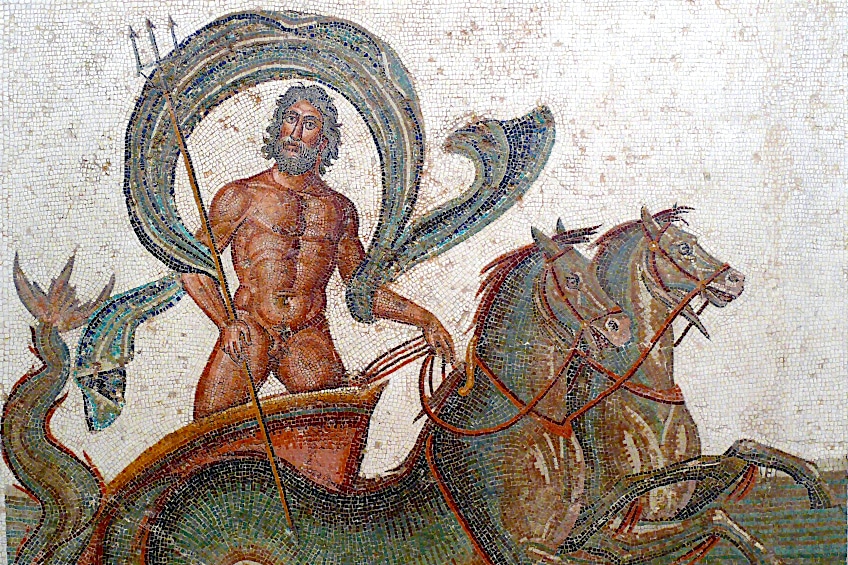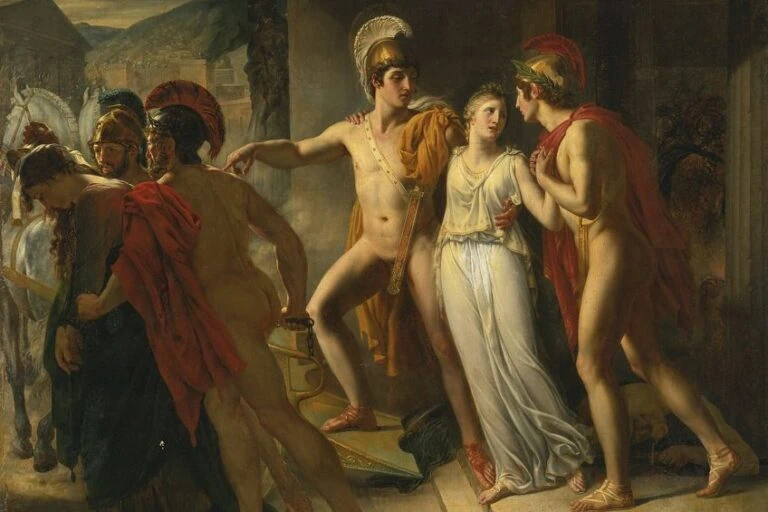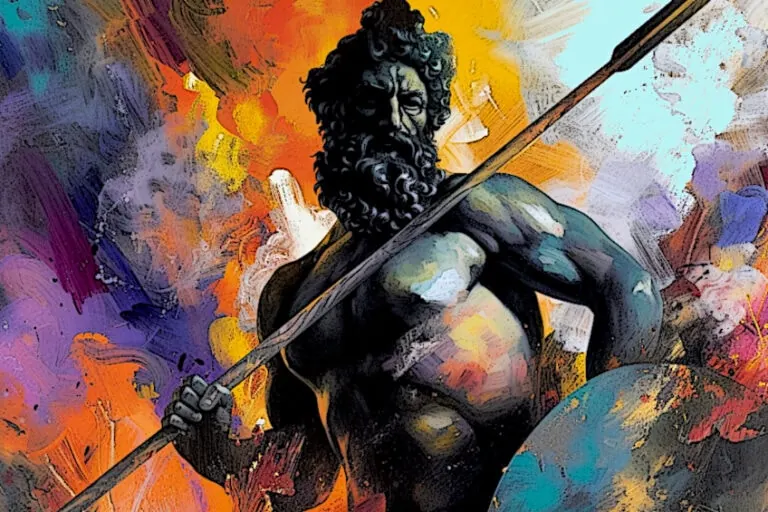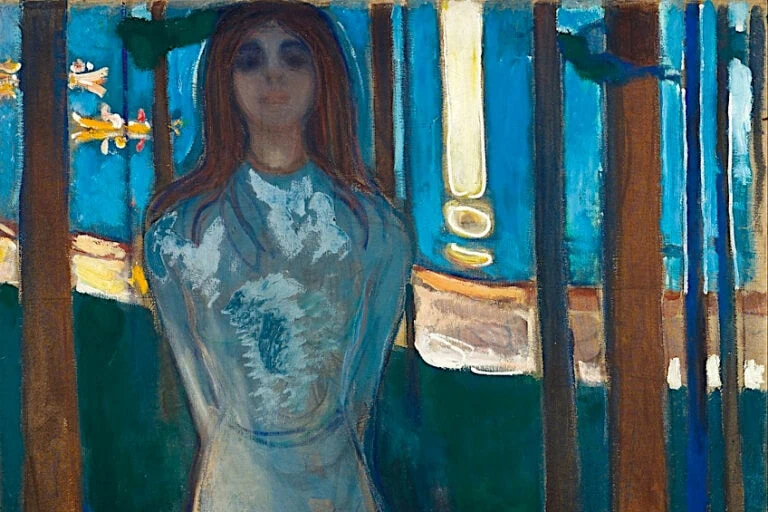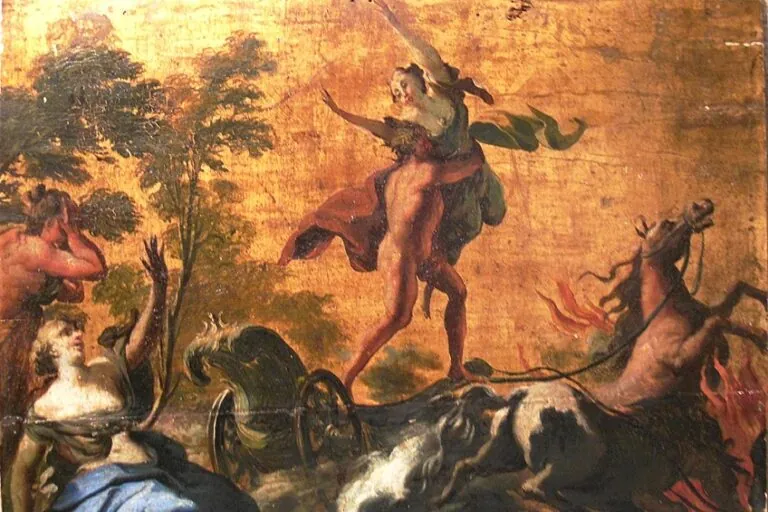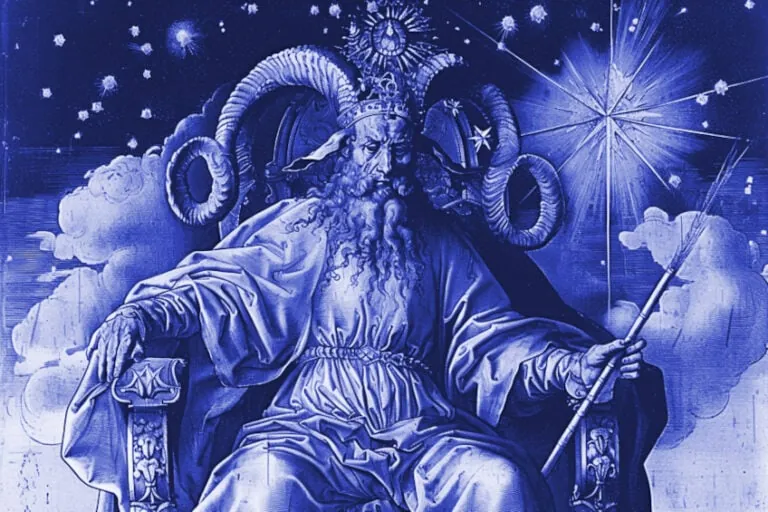Greek God Poseidon – Master of the Waves and Earthquakes
Who is Poseidon and what is Poseidon’s Roman name? The Greek god Poseidon is recognized in mythology as the god of the sea. The Romans identified him with their god Neptune. His domain also included rivers, floods, and earthquakes. Today, let’s find out more about Poseidon’s symbols and significance, as we explore Poseidon’s myths from the ancient Greek era.
Contents
The Mythology of the Greek God Poseidon
| Name | Poseidon |
| Gender | Male |
| Parents | Chronos and Rhea |
| Siblings | The Olympians |
| Domain | Sea, rivers, floods, and earthquakes |
| Symbols | Trident, horse, dolphin, fish, and bull |
The Greek god Poseidon was typically regarded as the most disruptive of all the Greek deities, yet he wasn’t necessarily a negative force all the time. He was also the mariners’ protector as well as the creator and tamer of the first horses.
One of the most well-known of Poseidon’s myths involves his contest with Athena to win the patronage of the city of Athens.
He was also the god who famously in the Odyssey prevented the hero Odysseus from reaching his home until his rage for the mutilation of his son Polyphemus had subsided. But before we get into his myths, let’s learn more about the Greek god Poseidon’s origins and family.
 Corinthian plaque with a depiction of Poseidon (550-525 BCE); Louvre Museum, Public domain, via Wikimedia Commons
Corinthian plaque with a depiction of Poseidon (550-525 BCE); Louvre Museum, Public domain, via Wikimedia Commons
The Background and Family of Poseidon
Poseidon is mostly known as the Greek god of the sea and rivers, yet, he was also the god of earthquakes, and thus also connected to the land in many aspects. In fact, many of Poseidon’s oldest temples were located inland but often built around a pool, stream, or other water feature.
He is typically regarded as a moody and bad-tempered god who was vengeful against those who insulted him in any way.
But, where did the Greek god Poseidon originate from and who was his family?
The Origins and Family of Poseidon
Poseidon cults have been traced all the way back to the late Bronze Age and the Mycenaean civilization, as evidenced by Linear B tablets discovered at Pylos in Knossos in Crete and the Peloponnese. In fact, the deity appears to be among the most significant Mycenaean deities, which is probably expected given the culture’s apparent maritime abilities.
Poseidon may have been a hybrid of a pre-Greek god and an Indo-European god known as Potis.
Poseidon was the most important god of Pylos, and his cult was led by a priestess. The Greek god Poseidon was a child of Chronos and Rhea, and the sibling of Zeus and Hades in later Greek mythology. He played a significant role in the wars for universal domination between the Giants, Titans, and Olympians.
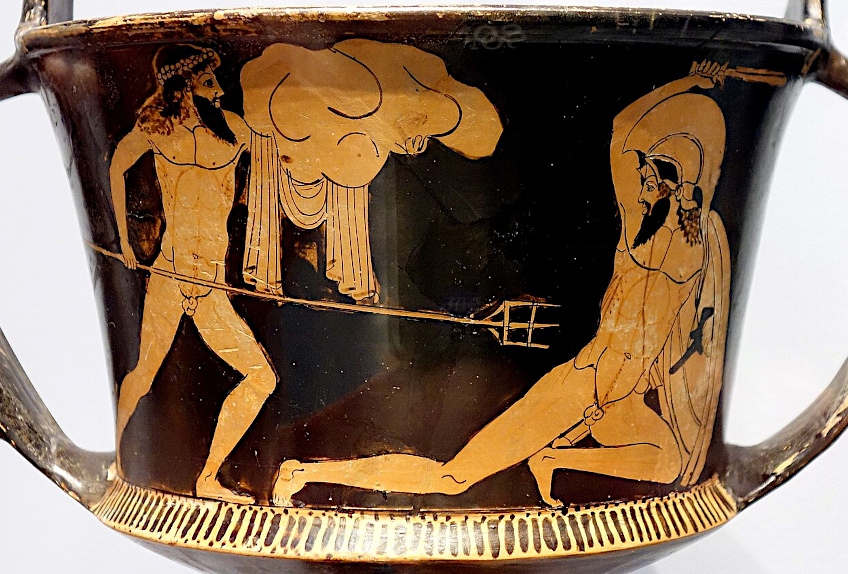 Attic red-figure kantharos with a depiction of Poseidon attacking a Giant with a boulder and trident (5th Century BCE); Mark Landon / Wikimedia Commons
Attic red-figure kantharos with a depiction of Poseidon attacking a Giant with a boulder and trident (5th Century BCE); Mark Landon / Wikimedia Commons
Following their victory, each of the brothers drew lots to determine which realm they would rule over, with Poseidon receiving control of the oceans. He lived beneath the sea in exquisite golden homes covered with sea flowers and coral. This underwater palace, which contained the god’s stables of magnificent white horses, was traditionally located close to Aega. Poseidon, apparently unsatisfied with only ruling the waters, regularly interfered in Zeus’ plans, and once tried to dethrone his brother with the help of Athena and Hera.
Poseidon was forced to create the majestic walls of Troy as a punishment for his treacherous attempts at overthrowing his brother.
Wife and Children
The wife of Poseidon was Amphitrite, who had been difficult during their courtship and had once even escaped and ran away to the Atlas mountains. The god of the sea was assisted, however, by Delphinus, the Dolphin, who convinced Amphitrite to return back home and marry the Greek god Poseidon. To show his gratitude, he made sure that Delphinus would be remembered for all eternity by creating a constellation in her image that still bears her name. Triton, the god’s most renowned offspring with Amphitrite, was half-fish, half-man. Benthesicyme and Rhode were the other two children.
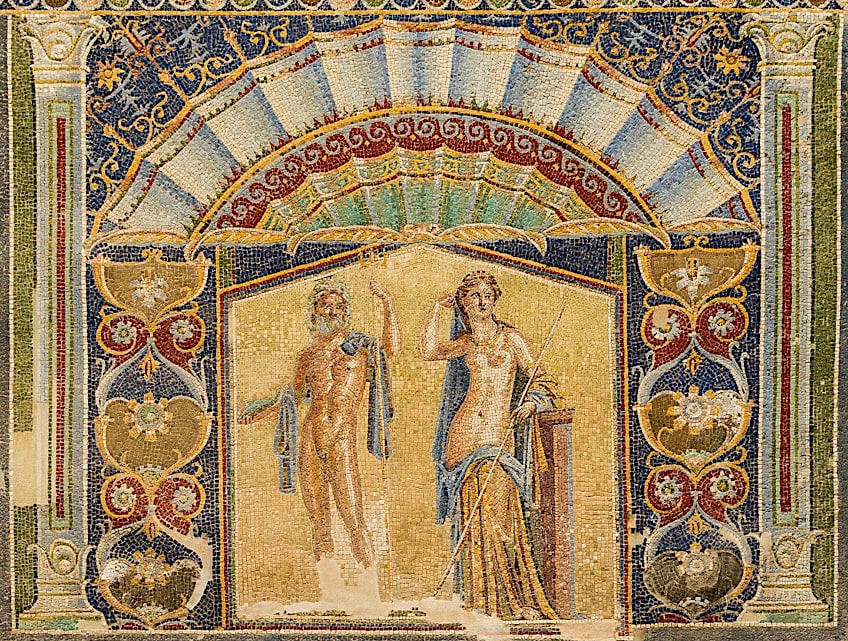 Roman mosaic depicting Poseidon/Neptune and Amphitrite from Herculaneum (1st Century CE); Jebulon, CC0, via Wikimedia Commons
Roman mosaic depicting Poseidon/Neptune and Amphitrite from Herculaneum (1st Century CE); Jebulon, CC0, via Wikimedia Commons
Poseidon, like the other gods, fathered multiple additional children with different lovers. Polyphemus the Cyclops, Theseus, Orion the Hunter, the winged horse Pegasus, and the ship-eating sea monster, Charybdis, are among the most famous. Poseidon’s obsession with Scylla, the daughter of the sea deity Phorcys, caused Amphitrite to cast some magical plants in the girl’s bath, transforming her into a roaring monster with six heads and 12 feet. Charybdis and Scylla would both pose a threat to mariners passing through the Strait of Messina, which connects Sicily and mainland Italy.
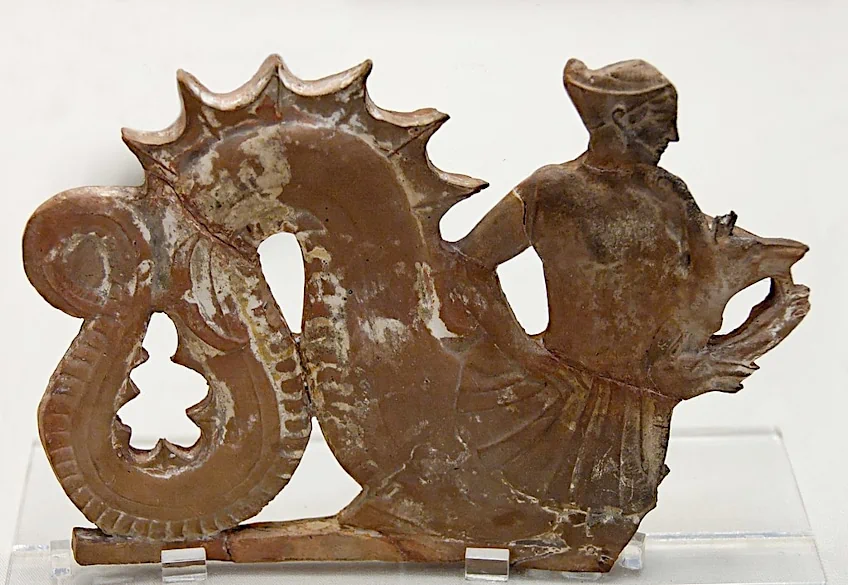 Terracotta plaque depicting the sea-monster Scylla (460-450 BCE); British Museum, Public domain, via Wikimedia Commons
Terracotta plaque depicting the sea-monster Scylla (460-450 BCE); British Museum, Public domain, via Wikimedia Commons
Cleito, a mortal woman, once resided on a solitary island; Poseidon fell in love with her and built a sanctuary atop a hill at the center of the island, encircled by rings of water and land to guard her. She had five pairs of twin sons, the first of which, Atlas, became the first king of Atlantis. Poseidon’s children were not all human. Polyphemus the cyclops blinded by Odysseus is one of his other offspring, as are Alebion, Bergion, Otos, and Ephialtae.
The famous philosopher Plato was thought by his contemporaries to have traced his ancestry to the god of the sea through his father Ariston and mythological forefathers the demigod kings Melanthus and Codrus.
Poseidon also took as a lover the son of Nereus and Doris, Nerites. This young man also served as Poseidon’s charioteer, and his speed astounded all sea animals. But one day, Helios, the sun god, transformed Nerites into a kind of shellfish. Aelian, who recounted this story as told by seafarers, speculates that Helios may have been upset in some way, or that he and Poseidon were competitors in love, and Helios preferred Nerites to spend time among the stars rather than with the sea monsters.
The Role of Poseidon in Ancient Greek Literature
Poseidon was a key character in Homer’s Trojan War in Iliad, where he supported the Greeks and either encouraged them with stirring speeches, regularly disguised as different Achaean individuals, or literally led them in combat with a shimmering sword. Poseidon did, however, assist Aeneas, the Trojan hero, in his escape from the formidable Achilles.
 Apollo and Poseidon Punishing Troy by Paolo Fiammingo (c. 1590); Paolo Fiammingo, Public domain, via Wikimedia Commons
Apollo and Poseidon Punishing Troy by Paolo Fiammingo (c. 1590); Paolo Fiammingo, Public domain, via Wikimedia Commons
Poseidon appears as Odysseus’ antagonist in Odyssey by Homer. In retaliation for the blinding of his son Polyphemus, Odysseus was condemned to travel the sea for 10 years. Both Hesiod and Homer describe Poseidon as the “ground-shaker”, and “earth-encircler”. The latter term recalls how many ancients thought that all streams were linked and that the earth floated on the water.
It made logical sense for one deity to oversee all of the earth’s waterways, even though numerous streams and rivers had their own distinct personifications in ancient Greek mythology.
The Personality and Attributes of Poseidon
Poseidon’s personality is often portrayed as forceful, volatile, and unpredictable, symbolizing the sea’s immense and wild nature. Poseidon is regarded as one of Greek mythology’s most powerful deities. He wields enormous influence and authority over the waters and all aquatic animals that live therein. His domain includes lakes, rivers, and any other associated bodies of water as well as the ocean.
Poseidon is notorious for his rage and vengeance. When he is enraged, he can bring about violent storms, massive earthquakes, and even tidal waves. His rage can often be directed at people who disobey or confront him.
Despite his turbulent personality, Poseidon also serves as a protector. He protects sailors and fishermen by providing them with safe passage and bountiful catches. He is revered as the patron deity of sailors, ensuring that they remain safe on their voyages. Poseidon is well-known for his competitiveness, usually competing with other gods or mankind. Poseidon adores horses and is often seen riding a chariot drawn by exquisite marine creatures or horses with golden manes. He is involved in horse breeding and equestrian sports.
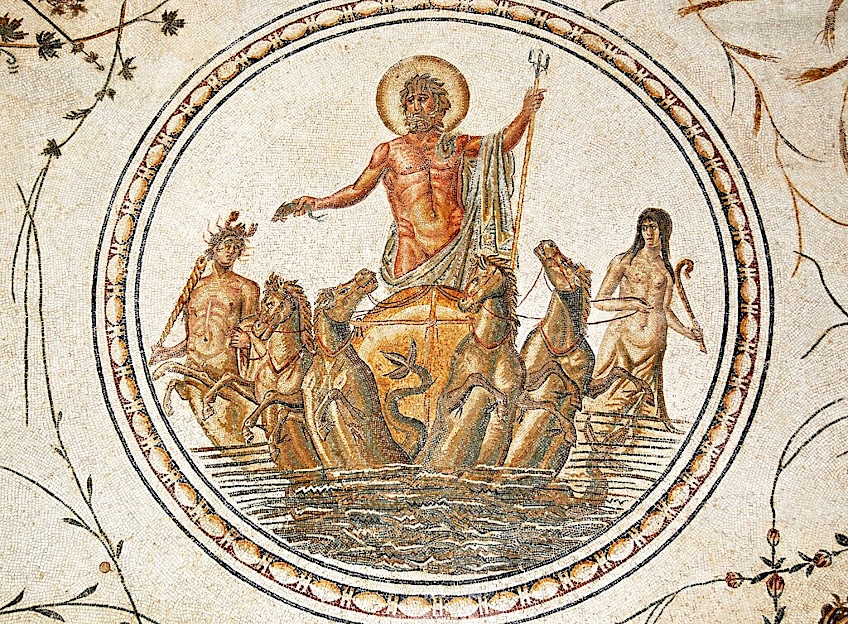 Roman mosaic depicting Poseidon/Neptune in his chariot drawn by Hippocampi and flanked by Triton and a Nereid (2nd Century CE); Ancient Roman art in the Bardo National Museum, CC BY-SA 2.0, via Wikimedia Commons
Roman mosaic depicting Poseidon/Neptune in his chariot drawn by Hippocampi and flanked by Triton and a Nereid (2nd Century CE); Ancient Roman art in the Bardo National Museum, CC BY-SA 2.0, via Wikimedia Commons
Poseidon’s Symbols
Poseidon’s most well-known symbol is the trident. This three-pronged fishing spear symbolizes his rule over the waters. The trident is portrayed as a dangerous weapon capable of summoning storms, causing earthquakes, and controlling the seas. Dolphins are revered by Poseidon and have a close connection with him. These clever and amiable animals are sometimes portrayed swimming beside his chariot or as companions in his domain. Dolphins are regarded as messengers and guardians of mariners, signifying Poseidon’s kindness and guidance.
Poseidon was often credited with creating the first horse, an association attributed to the foam caps on waves resembling galloping wild horses.
He usually appears riding a chariot drawn by horses or hippocampi (these are half-horse half-fish), symbolizing his dominion over both land and sea, despite being the god of the sea. Poseidon is associated with a variety of marine animals, including sea serpents, fish, and sea monsters.
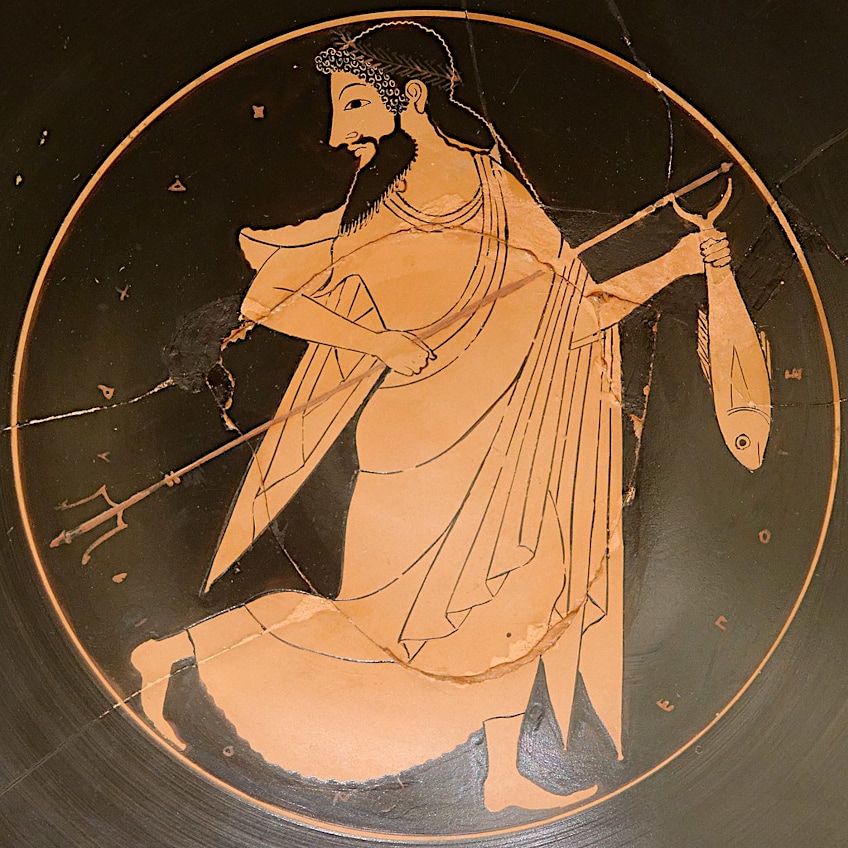 Tondo of an Attic red-figure kylix with a depiction of Poseidon holding a fish and trident (between 520-510 BCE); Oltos, Public domain, via Wikimedia Commons
Tondo of an Attic red-figure kylix with a depiction of Poseidon holding a fish and trident (between 520-510 BCE); Oltos, Public domain, via Wikimedia Commons
Poseidon is likewise represented with shells, particularly conch shells. They symbolize his connection to the sea and its depths. Conch shells are shown as tools used by Poseidon to express his instructions and call his sea monsters. Poseidon is often associated with bulls, which reflects his relationship to the soil and fertility, but also with earthquakes.
Poseidon is reported to have changed into a bull at various times in Greek mythology.
The Physical Appearance of Poseidon
Because he is a deity of force and strength, Poseidon is presented as having a towering, muscular build. Poseidon has free-flowing hair that is long and wavy.
His connection with the water is reflected by the fact that his hair is occasionally portrayed as blue-green or sea-colored.
In addition to having a thick, well-groomed beard, Poseidon is shown as having a dignified and mature demeanor. Poseidon is occasionally portrayed with a crown or wreath composed of different sea-related materials, like seaweed, coral, or shells.
Domains of Influence
Poseidon was a great civic deity in various towns: he was second only to Athena in significance in Athens, and he was the primary god of the polis in Corinth and many other cities in Magna Graecia. Poseidon was regarded favorably because he created new islands and provided calm waters. As the creator of horses, Poseidon was also considered a master horse-tamer and patron of equestrian skills.
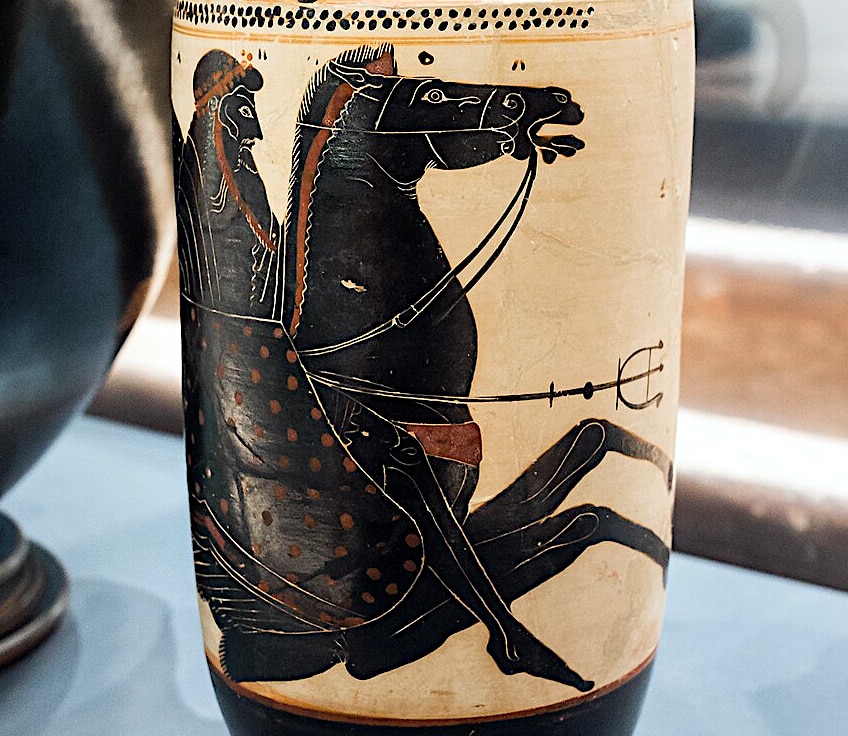 Black-figure white-ground lekythos with a depiction of Poseidon astride a hippocampus (500-480 BCE); ArchaiOptix, CC BY-SA 4.0, via Wikimedia Commons
Black-figure white-ground lekythos with a depiction of Poseidon astride a hippocampus (500-480 BCE); ArchaiOptix, CC BY-SA 4.0, via Wikimedia Commons
When he was insulted or neglected, he smashed the ground with his trident, causing chaos, drownings, earthquakes, and shipwrecks. An incomplete papyrus claims that Alexander the Great prayed and invoked Poseidon, the god of the sea, before the pivotal battle of Issus. He also asked that a four-horse chariot be thrown into the waters in his honor.
Sailors would often pray to Poseidon to ensure a safe voyage, occasionally drowning a few horses as a sacrifice.
Sites of Worship
Poseidon was thought to hold the Isthmus of Corinth in great regard in Greek religion, most likely because it was a vital maritime route. The deity was especially revered in this region, and he was the central figure of horse races and other activities during the Panhellenic Isthmian games, which took place near Corinth in his honor. Corinth was one of the first cities to associate Poseidon with marine navigation and trade, as evidenced by Archaic votive clay plaques. Sounion was another important location for the deity, and the remains of his 5th-century BCE temple still exists on a hillside overlooking ships approaching the Saronic Gulf.
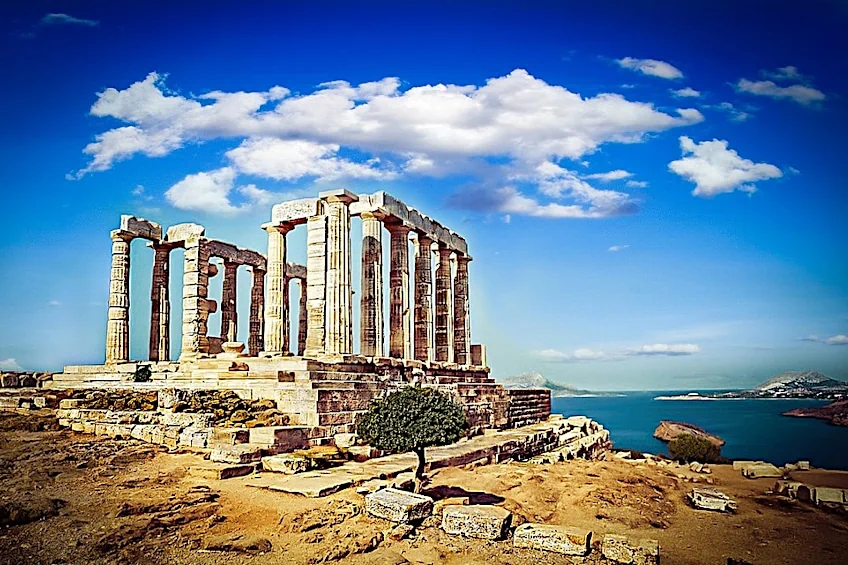 The remains of the temple of Poseidon at Sounion (440-444 BCE); VasiliosGavrilis, CC BY-SA 4.0, via Wikimedia Commons
The remains of the temple of Poseidon at Sounion (440-444 BCE); VasiliosGavrilis, CC BY-SA 4.0, via Wikimedia Commons
Boat races were staged at the cape once every four years to honor Poseidon. In the form of Poseidon Asphaleios, the Greek deity was invoked as a protector during earthquakes (despite also being considered as their source), and a shrine to the god was constructed on Rhodes for that reason. Poseidon also had an oracle at Taenarum in Laconia, as well as noteworthy shrines on the tiny island of Calauria off the coast of Troezen.
In Boeatia, Onchestus had a strange ritual in which horses pulled a riderless chariot past the site, and if it smashed into something then the chariot was devoted to Poseidon.
Many coastal villages were named after him across the Mediterranean, and seafarers and fishermen offered votive gifts to the god of the sea for protection. His devotees regularly sacrificed stallions, bulls, and male lambs. Poseidon was attributed with being the father of at least 30 distinct city-founders and numerous significant tribes throughout Greece, demonstrating the god’s influence throughout the Mycenaean era. Under the name Neptune, the cult of the Greco-Roman god of the sea spread as far as the outer reaches of the Roman Empire.
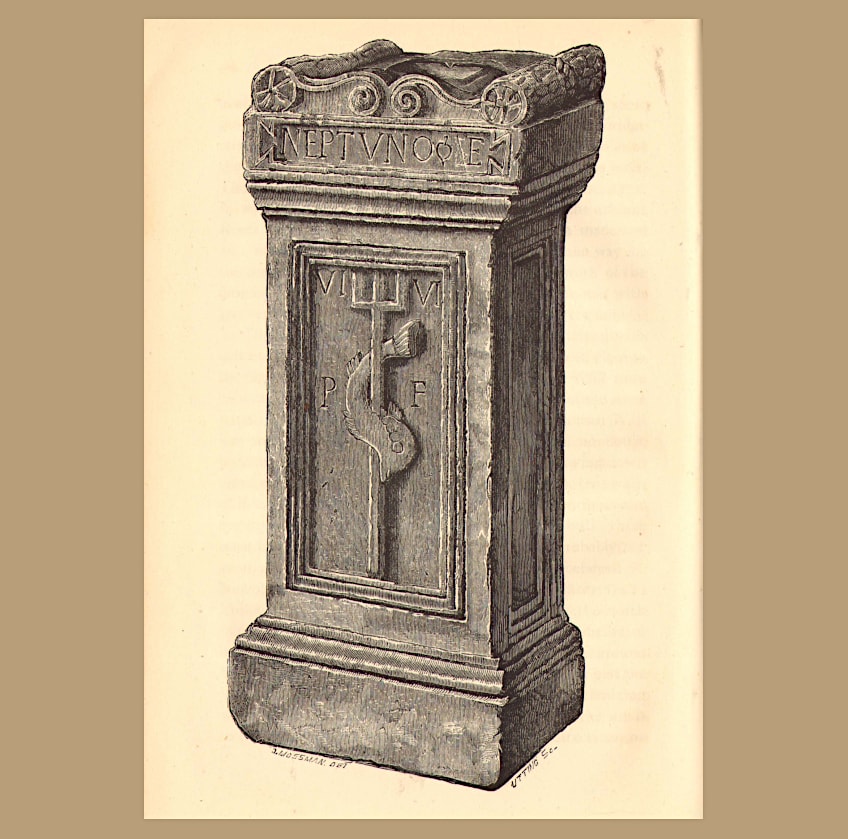 Illustration of an altar erected by the sixth Roman Legion to Neptune/Poseidon found in the River Thyne in Newcastle, Britain during the late 19th Century (published 1885); John Collingwood Bruce, Public domain, via Wikimedia Commons
Illustration of an altar erected by the sixth Roman Legion to Neptune/Poseidon found in the River Thyne in Newcastle, Britain during the late 19th Century (published 1885); John Collingwood Bruce, Public domain, via Wikimedia Commons
In many realms, Poseidon and Apollo collaborated closely: for instance, in colonization, Delphic Apollo granted the license to go out and settle, while Poseidon kept an eye on the colonists on their journey and supplied the lustral waters for the foundation sacrifice. Poseidon, along with other Greek gods, is still venerated in modern Hellenic religion. Since 2017, the Greek government has acknowledged Greek deity worship.
The Isthmian Games
The mythological hero Theseus, who was linked with the city of Corinth, was said to have organized the Isthmian Games. According to tradition, Theseus founded these athletic events to honor his divine father Poseidon.
The games occurred every two years in the springtime, when charioteers, athletes, and horse racers fought for prizes, in this instance a coveted crown of initially, pine and then, in the Classical era, dried celery.
The Isthmian Games comprised athletic disciplines as well as musical and artistic categories. Foot races, boxing, wrestling, chariot races, and the pentathlon were among the athletic events, which were comparable to those seen in the Olympic Games.
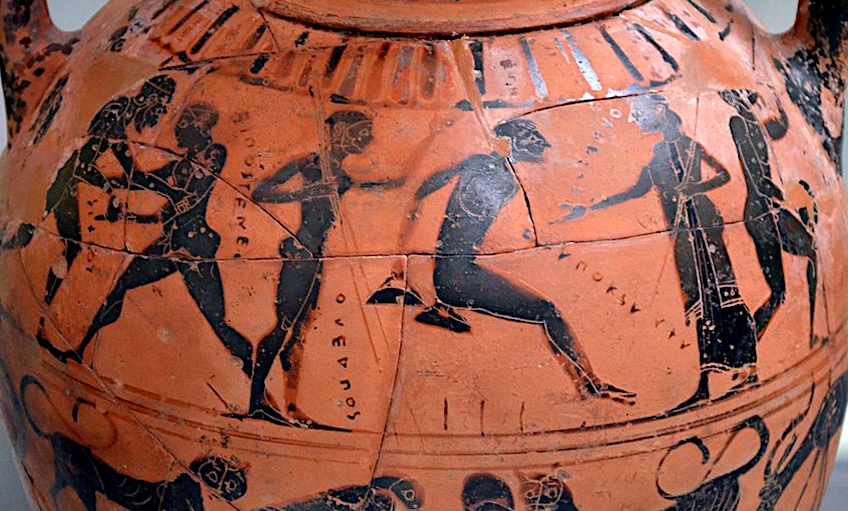 Black-figure Tyrrhenian amphora depicting athletes competing in four events of the ancient Greek pentathlon (540 BCE); Carole Raddato from FRANKFURT, Germany, CC BY-SA 2.0, via Wikimedia Commons
Black-figure Tyrrhenian amphora depicting athletes competing in four events of the ancient Greek pentathlon (540 BCE); Carole Raddato from FRANKFURT, Germany, CC BY-SA 2.0, via Wikimedia Commons
The Isthmian Games, like the other Panhellenic Games, featured a major religious component. Sacrifices and rituals would be performed to worship Poseidon by participants and onlookers. The champions were crowned with a garland made of pine leaves, representing the region’s relationship to the pine trees. The Isthmian Games were a meeting of Greek city-states that facilitated relationships, trade, and cultural exchange. They were regarded as prestigious and drew spectators and athletes from all around Greece.
The games were both politically and diplomatically significant since they allowed city-states to demonstrate their dominance and create alliances.
The Greek God Poseidon’s Myths
Poseidon shares much of the same birth story as his brothers and sisters due to being swallowed by their father, Chronos. Luckily, one of the children, Zeus, was not swallowed and subsequently made Chronos regurgitate all of the children, including Poseidon. Poseidon avoided being consumed by his father in a later version of this myth, as his mother Rhea protected him in the same way she saved Zeus, this time by presenting Chronos a foal instead, stating she had given delivered to a horse rather than a god when in reality, she left the boy with the flock. Rhea gave her child to a spring nymph to raise.
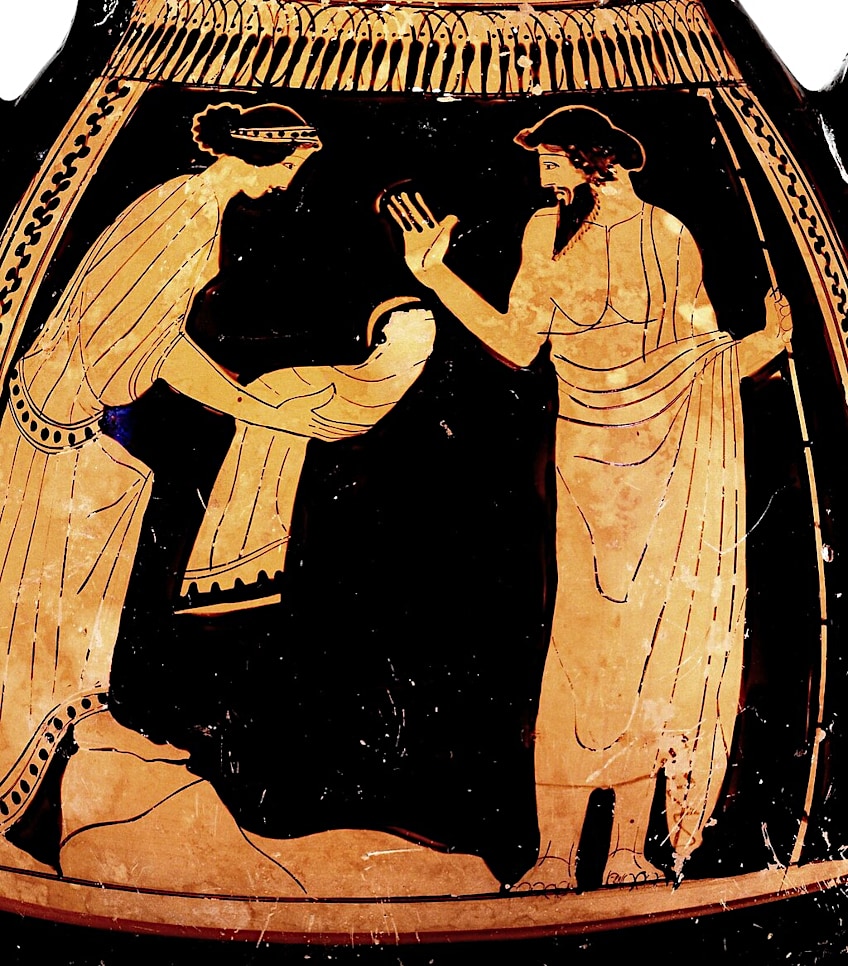 Vase painting showing Rhea handing Cronus a stone disguised as one of their children (460-450 BCE); attribuito al it:Pittore di Nausicaa, Public domain, via Wikimedia Commons
Vase painting showing Rhea handing Cronus a stone disguised as one of their children (460-450 BCE); attribuito al it:Pittore di Nausicaa, Public domain, via Wikimedia Commons
When Chronos demanded that the child be returned, the nymph Arne claimed she did not have him. In another story, Rhea gave Poseidon to the Telchines, the ancient residents of Rhodes; an Oceanid nymph named Capheira became the infant god’s nanny. Poseidon grew up and became infatuated with Halia, the lovely Telchines’ sister, and produced six boys and one daughter with her. The goddess of love, Aphrodite, had risen from the sea by that time and sought to rest in Rhodes on her journey to Cyprus. When Poseidon and Halia’s children refused to entertain her, Aphrodite cursed them to rape Halia. Poseidon then forced them to sink beneath the sea.
The Foundation of Athens
Poseidon and Athena each wanted to be patron of the city of Athens. They decided that each of them would offer the Athenians a present, and the Athenians would then choose the present of their choice. Poseidon hit the earth with his trident, causing a spring to appear; the water that emerged, however, was salty and therefore, useless to the Athenians, but Athena gifted them an olive tree. The Athenians chose the olive tree because it provided them with timber, oil, and food. Poseidon, enraged at his defeat, brought a terrible flood on the Attic Plain in order to punish the Athenians for not picking his gift.
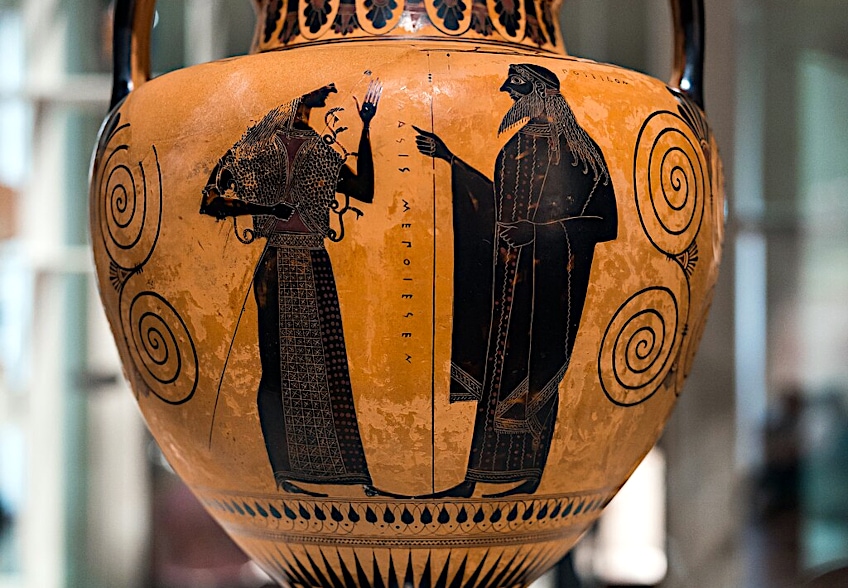 Attic black-figure neck amphora depicting Poseidon and Athena (c. 540-530 BCE); ArchaiOptix, CC BY-SA 4.0, via Wikimedia Commons
Attic black-figure neck amphora depicting Poseidon and Athena (c. 540-530 BCE); ArchaiOptix, CC BY-SA 4.0, via Wikimedia Commons
The indent created by Poseidon’s trident on the acropolis in Athens filled with salt water and was later encircled by the Erechtheum’s northern hall, which remained open to the air. Poseidon is also thought to have dispatched one of his sons, Halirrhothius, to chop down Athena’s olive tree following his loss.
However, as Halirrhothius wielded his axe, he misjudged his target and the axe landed on himself, slaying him instantly.
Poseidon, enraged, charged Ares with the murder, and the dispute was finally decided on the Areopagus in Ares’ favor. According to other versions of this story, Halirrhothius raped Ares’ daughter, and Ares murdered him. Poseidon was outraged about his son’s murder, and Ares was therefore imprisoned, which finally resulted in his acquittal.
Poseidon and Other Cities
The Corinthians established a tale about their own city Corinth that was comparable to Athens’. According to legend, Helios and Poseidon battled over ownership of the city. Their disagreement was presented before Briareos, an elder deity, who was entrusted with settling the conflict between the two deities. Briareus agreed to give Poseidon the isthmus of Corinth and Helios the Acrocorinth.
Poseidon and Helios were chosen to represent water and fire in this story. Helios, the sun god, was given the region closest to the sky, while Poseidon, the sea deity, was given the isthmus near the sea.
Poseidon made a deal with another goddess, Leto, in which he gave her the island of Delos in return for Calauria; he also traded Delphi for Taenarum with Apollo. During ancient times, Calauria was home to a Poseidon temple. Poseidon also went to Argos to fight with his sister Hera for the city. Phoroneus, a local ruler, had been selected to resolve the case, and he decided to gift the city to Hera, who subsequently became its patroness. Poseidon grew enraged and unleashed a drought to wreak havoc on the city.
Poseidon and Theseus
Poseidon slept with Aethra and had Theseus with her. However, Theseus was also claimed to be the King of Athens, Aegeus’ son, who had slept with Aethra the very same night. Thus, Both the divine and human elements were present in Theseus’ origin story. Meanwhile, in Crete, Zeus’ son Minos sought Poseidon’s assistance in validating his claim to the kingdom of Crete. Poseidon gave Minos a magnificent white bull on the condition that he subsequently slaughter the bull and offer it to Poseidon. Minos was crowned ruler of Crete because the Cretans were so taken by the bull.
However, in order to keep the gorgeous bull for himself, Minos rather sacrificed an ordinary bull instead. Angered by this, Poseidon had Minos’ wife, Pasiphae, become deeply in love with the bull, resulting in the Minotaur, a hybrid beast who dined on human flesh.
Minos then hid him within Daedalus’ labyrinth and fed him seven Athenian youths and seven Athenian maidens sent as tribute to Crete every year. When Theseus reached adulthood and was acknowledged by his father Aegeus, he resolved to put an end to the awful price that Athens had to pay to Crete for good and offered to sail to Crete with the other young Athenians. Upon his arrival in Crete, Theseus was insulted by Minos, who claimed that there was no way that he could possibly be the son of the mighty Poseidon.
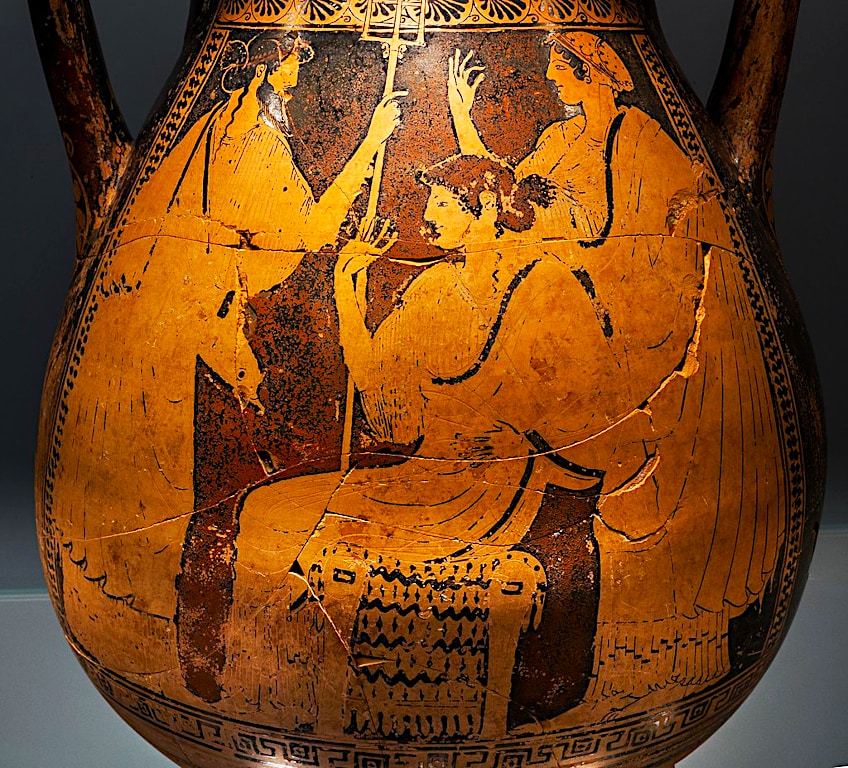 Attic red-figure vase with a depiction of Theseus seated and flanked by Poseidon and a Goddess (c. 480 BCE); ArchaiOptix, CC BY-SA 4.0, via Wikimedia Commons
Attic red-figure vase with a depiction of Theseus seated and flanked by Poseidon and a Goddess (c. 480 BCE); ArchaiOptix, CC BY-SA 4.0, via Wikimedia Commons
So, he took his ring and threw it into the sea, telling Theseus to get it back, thinking that he would not be able to. However, Theseus dove straight into the water. Dolphins soon appeared as escorts and led him to Poseidon’s royal halls, where he was enthusiastically greeted. Amphitrite gave him the ring, as well as a purple bridal robe and a crown, to verify his claims of being the son of Poseidon. The ring was then given to Minos by Theseus once he resurfaced from the water.
Theseus defeated the Minotaur, and he eventually succeeded his mortal father as king of Athens.
He then had a son, named Hippolytus, from an Amazon, and two boys with his wife, Phaedra (Minos’ daughter). Theseus had abandoned Minos’ other Daughter Ariadne en route to Athens, even though she had given him the golden thread and the weapon he needed to defeat the Minotaur. Poseidon promised Theseus three favors at some point, and he asked Poseidon to carry out one of them when Phaedra unjustly charged Hippolytus with trying to force himself on her. Unaware that it was a lie, Theseus begged Poseidon to kill Hippolytus; Poseidon fulfilled his son’s request, and when Hippolytus drove past the sea, Poseidon sent a fearsome sea monster to frighten the man’s horses, which subsequently pulled him to his death.
Poseidon and Zeus
Zeus’ wife was Hera, and Apollo was his son with Leto. When Zeus was hard on the other deities, Hera persuaded them to revolt against him. Apollo, Hera, and Poseidon organized the uprising. Hera poisoned Zeus and chained him on his bed, stealing his thunderbolt. Briareus, who had been released from Tartarus by Zeus, heard their conversations and realized that Zeus was confined. He crept in and unbound Zeus, who was enraged by the revolt and punished the other deities.
In order to atone for their roles in the unsuccessful uprising, Apollo and Poseidon were transported to Phrygia to work as slaves to King Laomedon for a year. The famed impenetrable walls of Troy were created by the two gods working together during this time.
Poseidon and Medusa
Medusa was a stunningly attractive priestess of the goddess Athena. Being a virgin was a prerequisite for becoming an Athena priestess. Poseidon lusted after Medusa and went to great lengths to find and pursue her. Medusa attempted to flee by rushing to the Temple of Athena. However, Medusa was discovered by Poseidon, who raped her on the temple floor.
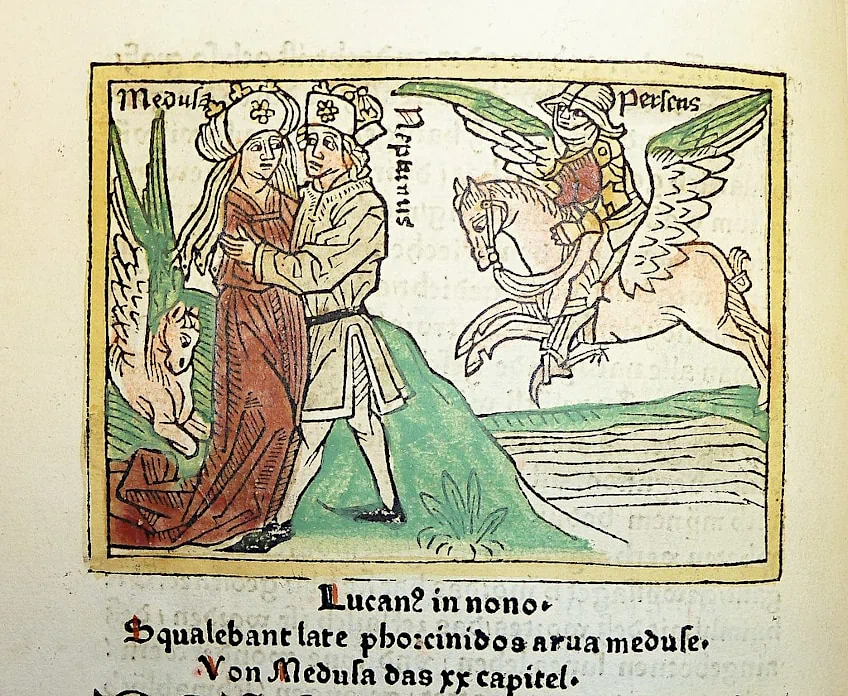 Woodcut illustration of Neptune/Poseidon embracing Medusa with a winged horse as Perseus astride Pegasus approaches (c. 1472); kladcat, CC BY 2.0, via Wikimedia Commons
Woodcut illustration of Neptune/Poseidon embracing Medusa with a winged horse as Perseus astride Pegasus approaches (c. 1472); kladcat, CC BY 2.0, via Wikimedia Commons
Athena was enraged when she discovered this. As punishment for forsaking her purity, Athena turned Medusa’s gorgeous hair into serpents and twisted her features into something so terrifying that the sheer sight of her face could turn observers to stone. Medusa was thus transformed into a monster.
Years later, the hero Perseus slayed Medusa, and Pegasus and Chrysaor sprung from her neck as a result. They are thought to be the offspring of Poseidon and Medusa.
Poseidon and Demeter
Demeter was the goddess of agriculture, grain, harvesting, growth, and sustenance. Poseidon once attempted to pursue Demeter, but she turned herself into a horse in order to avoid him. She proceeded to join a herd of King Onkios’ horses and vanished in the midst of the chaos. Even in the guise of a horse, she couldn’t hide her divinity. Poseidon observed this and deceived Demeter by changing into a stallion and joining the herd. He then made her mate with him.
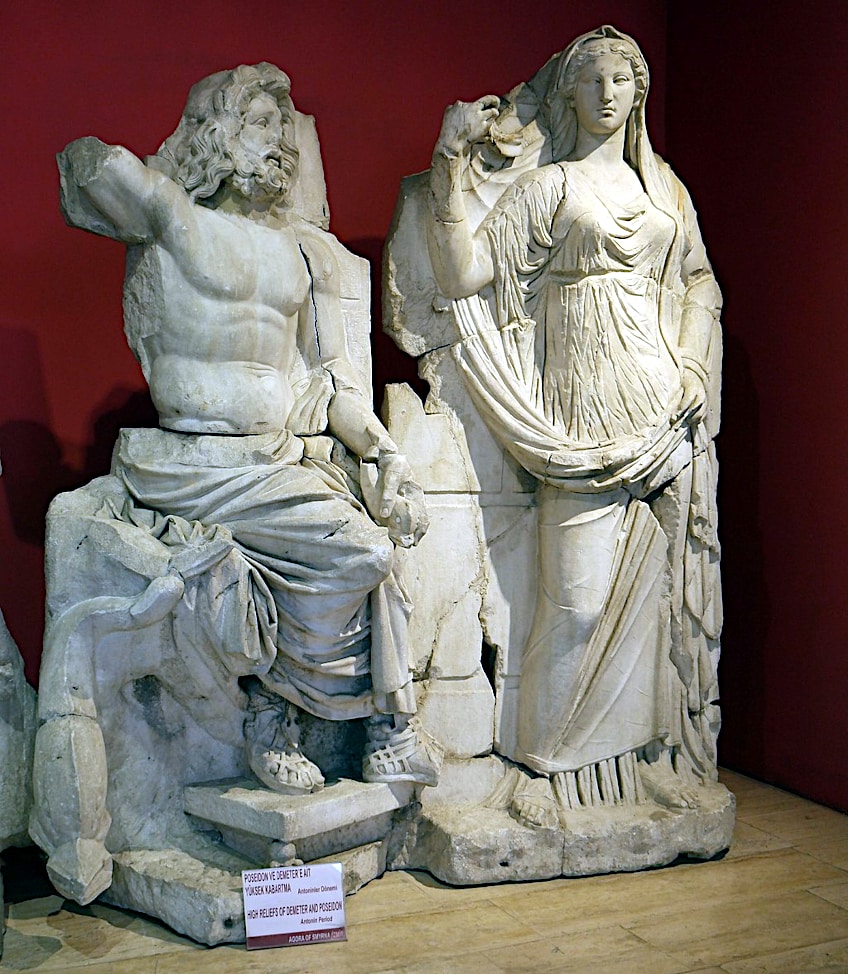 Statues of Poseidon and Demeter from the Agora of Smyrna (between the 1st Century BCE and the 2nd Century CE); Isabeau, CC BY-SA 4.0, via Wikimedia Commons
Statues of Poseidon and Demeter from the Agora of Smyrna (between the 1st Century BCE and the 2nd Century CE); Isabeau, CC BY-SA 4.0, via Wikimedia Commons
Demeter was enraged at the assault and went into a cave to cleanse herself. Her departure caused considerable crop loss and cattle death, resulting in a worldwide famine. She eventually washed her rage away in the River Ladon. Demeter then gave birth to a daughter named Arion, a horse with the capacity to understand human language as a result of her sleeping with Poseidon.
Legacy and Influence
In ancient Greek art, Poseidon typically appears as a mature adult and bearded. He wields his Cyclops-created trident, with which he was known to cause earthquakes by hitting it on the ground. He is also typically observed riding his golden chariot, which is drawn by hippocamps, hybrid horse/serpent animals with fishtails. Other aquatic animals that are often portrayed in Poseidon’s company in art are seahorses, tuna fish, and dolphins.
 Mosaic depicting Poseidon/Neptune in his chariot (mid 3rd Century); Sousse Archaeological Museum, CC BY-SA 3.0, via Wikimedia Commons
Mosaic depicting Poseidon/Neptune in his chariot (mid 3rd Century); Sousse Archaeological Museum, CC BY-SA 3.0, via Wikimedia Commons
On the western pediment of the Parthenon, the deity competes with Athena for the title of patron of Athens. Poseidon is also featured on currency from that time, most notably the ancient Macedon’s silver tetradrachms, where he appears to be poised to hurl his trident.
Influence Through the Ages
Greek mythology and deities, including Poseidon, were absorbed into Roman society as the Roman Empire grew. Poseidon was associated with the Roman deity Neptune, with whom he shared many qualities and realms. Neptune is often depicted in Roman art, similar to Poseidon, as a bearded deity clutching a trident and surrounded by marine animals.
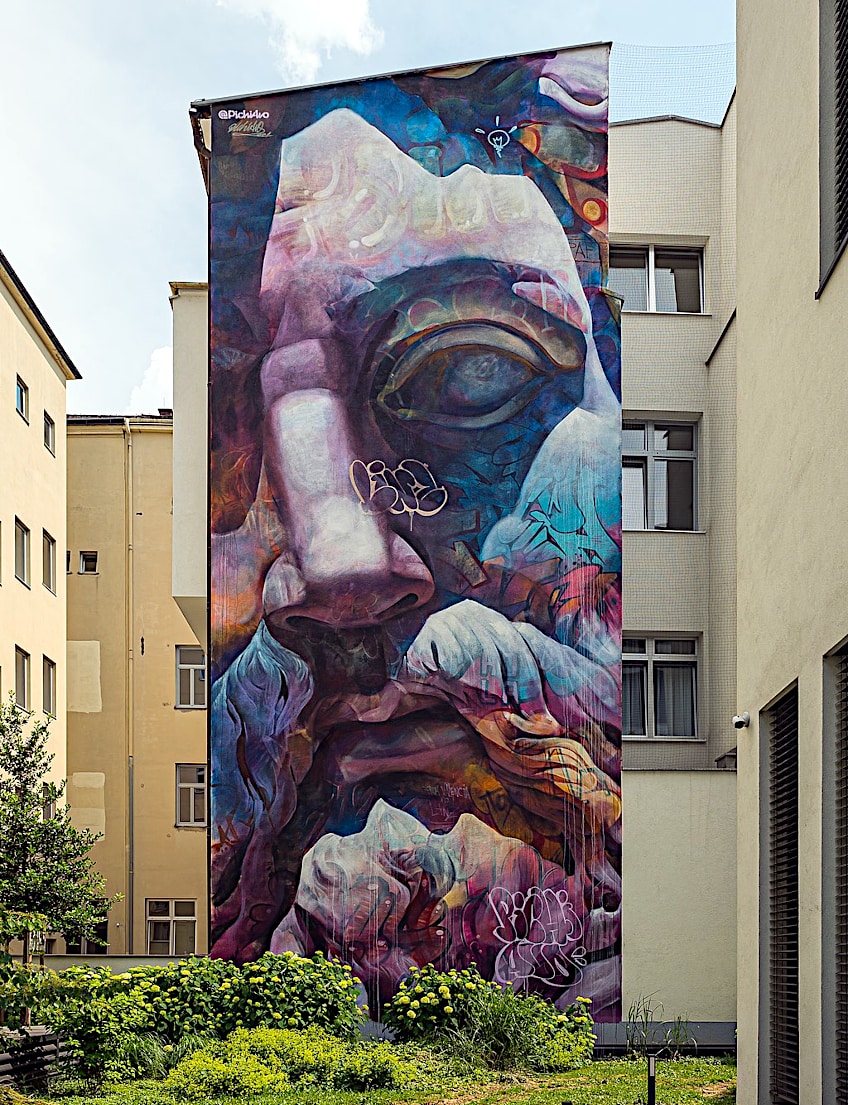 Mural depicting Poseidon in the courtyard of the Promenadengalerie Linz by PichiAvo (2021); Isiwal, CC BY-SA 4.0, via Wikimedia Commons
Mural depicting Poseidon in the courtyard of the Promenadengalerie Linz by PichiAvo (2021); Isiwal, CC BY-SA 4.0, via Wikimedia Commons
There was a resurgence of interest in classical mythology and the gods during both the Baroque and Renaissance eras. Artists were inspired by ancient Greek and Roman themes, resulting in novel depictions of Poseidon. He was portrayed in a variety of artworks and sculptures, with a focus on his power and domination over the sea. The Neoclassical movement was inspired by the aesthetic techniques and subjects of ancient Greece and Rome in the 18th and 19th centuries.
Poseidon and other legendary characters were prominent subjects in Neoclassical paintings. Painters and sculptors depicted him heroically and idealistically, stressing his physical power and divine characteristics.
Poseidon is still an enduring figure in art, literature, and popular culture today. He has appeared in a variety of media, including novels, films, and video games. Modern renditions of Poseidon draw influence from ancient sources but may integrate modern characteristics to suit the story or aesthetic style.
With that, we come to the end of this article on the Greek god Poseidon. As the god of the sea, he had significant power over the oceans, rivers, and all the animals that lived therein. However, his rule also extended to the land and he was known as the patron of horses. After being freed from the belly of Chronos, the realms were split up between him and his two other brothers: Hades got the underworld, Zeus got the skies, and Poseidon got the seas.
Frequently Asked Questions
Who Is Poseidon?
Poseidon is a mighty Greek god and is regarded as one of the 12 Olympian gods. He is brother to Zeus, Hades, Hera, Demeter, and Hestia. His position within the Greek pantheon is as the god of the seas and other bodies of water. As master of waves he was also considered responsible for earthquakes, which in the Mediterranean region often resulted in tsunami’s. The Romans associated Poseidon with their god Neptune.
What Are Poseidon’s Symbols?
As the god of the seas, many of Poseidon’s symbols are aquatic. Of course, the most well-known of Poseidon’s symbols is his mighty trident or fishing spear. Another of Poseidon’s symbols is the fish and in particular, the dolphin, an animal that is sacred to him. As the white foam caps on waves were believed to be the god’s herd of wild galloping horses, Poseidon was closely associated with this animal. As source of earthquakes, Poseidon was also symbolized by the bull.

I am deeply passionate about history and am constantly fascinated by the rich and complex stories of the past. As the editor-in-chief of learning-history.com, I have the opportunity to share this passion with a wide audience through the creation and distribution of engaging and informative content about historical events, persons, and cultures. Whether it’s through writing articles and blog posts or creating videos or podcasts, I strive to bring the past to life in a way that is both accurate and enjoyable. My expertise in history, combined with my strong writing and communication skills, allows me to effectively communicate complex historical concepts and make them accessible and interesting to a wide range of readers. I am truly grateful for the opportunity to share my love of history with others through my work on learning-history.com.

